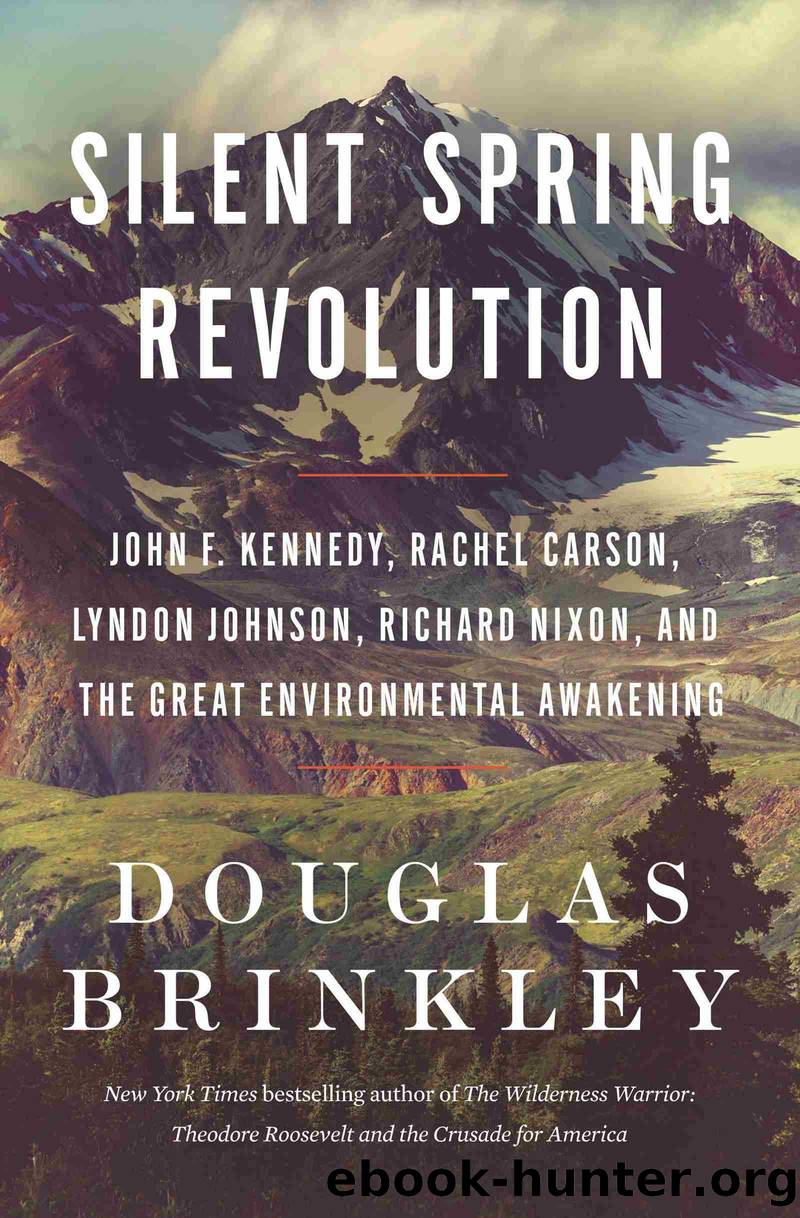Silent Spring Revolution by Douglas Brinkley

Author:Douglas Brinkley
Language: eng
Format: epub
Publisher: HarperCollins
Published: 2022-10-21T00:00:00+00:00
Chapter 23
Americaâs Natural Heritage
Cape Lookout, Big Bend, the Grand Canyon
American environmental activist David Brower (1912-2000) (center), executive director of the Sierra Club, leads an ultimately successful protest against the proposed construction of dams on the Colorado River near the Grand Canyon National Park, Arizona, 1966.
Arthur Schatz / The LIFE Picture Collection / Shutterstock
I
When Lyndon Johnson ratcheted up the Great Societyâs commitment to preserve what he called âAmericaâs natural heritageâ in his special message to Congress on February 23, 1966, he didnât need to search for a constituency; most Washington lawmakers were on his side. Point by point, the president offered specific conservation measures to fight air pollution, make cities healthy places, and save historic places, in addition to his extensive reform plan to clean the nationâs waters. David Brower, Marjory Stoneman Douglas, Barry Commoner, and all those preservationists who had, as he once said, âstood up against private greed for public good,â were enthralled. In fact, Johnson began the special message by quoting the epigraph of Silent Spring, Albert Schweitzerâs warning: âMan has lost the capacity to foresee and to forestall. He will end by destroying the earth.â1
Americans in the twenty-first century should read the âNatural Heritageâ speech to understand conservation leadership at its best. Only Theodore and Franklin Roosevelt equaled Johnson in prioritizing preservation and then driving appropriate measures into law around the power of his persuasive personality. Johnson rhapsodized about saving âuncharted forests, broad sparkling rivers, and prairies ripe for planting,â using language that could have been lifted from Walt Whitmanâs Leaves of Grass. Then, sounding like John Steinbeck, the president insisted that California redwood groves be spared the lumbermanâs ax, for they were ambassadors from another time. Once again, he made it clear that national lakeshores needed to be established in Michigan, Wisconsin, and Indiana. Underneath the picturesque imagery, though, his special message was a warning in the style of Silent Spring. He said, âWe see that we can corrupt and destroy our lands, our rivers, our forests and the atmosphere itselfâall in the name of progress and necessity. Such a course leads to a barren America, bereft of its beauty, and shorn of its sustenance.â2
Johnsonâs preservation theme was clear: the country was grappling with an unprecedented environmental crisis. Treasured landscapes had been compromised by synthetic pesticides, industrial debris, poor planning, and pollution of every type. He vowed to bend the will of Congress to pass bills aimed at arresting the unacceptable degradation of Americaâs natural resources. Backed with fresh scientific data from the blockbuster report of the Environmental Pollution Panel of the Presidentâs Science Advisory Committee report, released in November 1965, he was well prepared to win Congress over. He described in heartbreaking detail the destruction of Americaâs major rivers such as the Ohio, Mississippi, and Missouri by the discharge of treated and untreated sewage collected from a population of nearly 50 million citizens. Sounding like Bill Douglas on the loose, he lashed out at the chemical industries for poisoning rivers with by-products that wouldnât break down benignly in the water.
Download
This site does not store any files on its server. We only index and link to content provided by other sites. Please contact the content providers to delete copyright contents if any and email us, we'll remove relevant links or contents immediately.
Hit Refresh by Satya Nadella(9040)
When Breath Becomes Air by Paul Kalanithi(8334)
The Girl Without a Voice by Casey Watson(7824)
A Court of Wings and Ruin by Sarah J. Maas(7653)
Do No Harm Stories of Life, Death and Brain Surgery by Henry Marsh(6891)
Shoe Dog by Phil Knight(5147)
Hunger by Roxane Gay(4869)
The Rules Do Not Apply by Ariel Levy(4866)
A Higher Loyalty: Truth, Lies, and Leadership by James Comey(4851)
Tuesdays with Morrie by Mitch Albom(4696)
Everything Happens for a Reason by Kate Bowler(4680)
The Immortal Life of Henrietta Lacks by Rebecca Skloot(4528)
Millionaire: The Philanderer, Gambler, and Duelist Who Invented Modern Finance by Janet Gleeson(4386)
How to Change Your Mind by Michael Pollan(4292)
All Creatures Great and Small by James Herriot(4233)
The Money Culture by Michael Lewis(4083)
Man and His Symbols by Carl Gustav Jung(4070)
Elon Musk by Ashlee Vance(4033)
Tokyo Vice: An American Reporter on the Police Beat in Japan by Jake Adelstein(3937)
